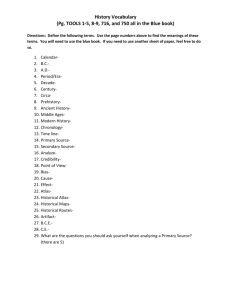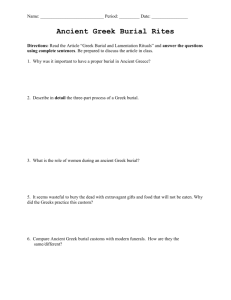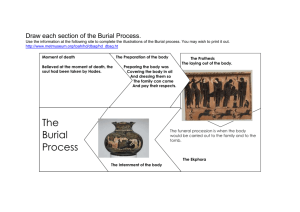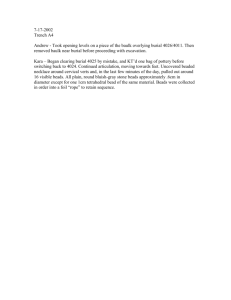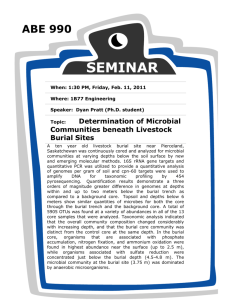DOCUMENTATION AND VISUALIZATION OF ANCIENT BURIAL MOUNDS BY HELICOPTER LASER SURVEYING
advertisement
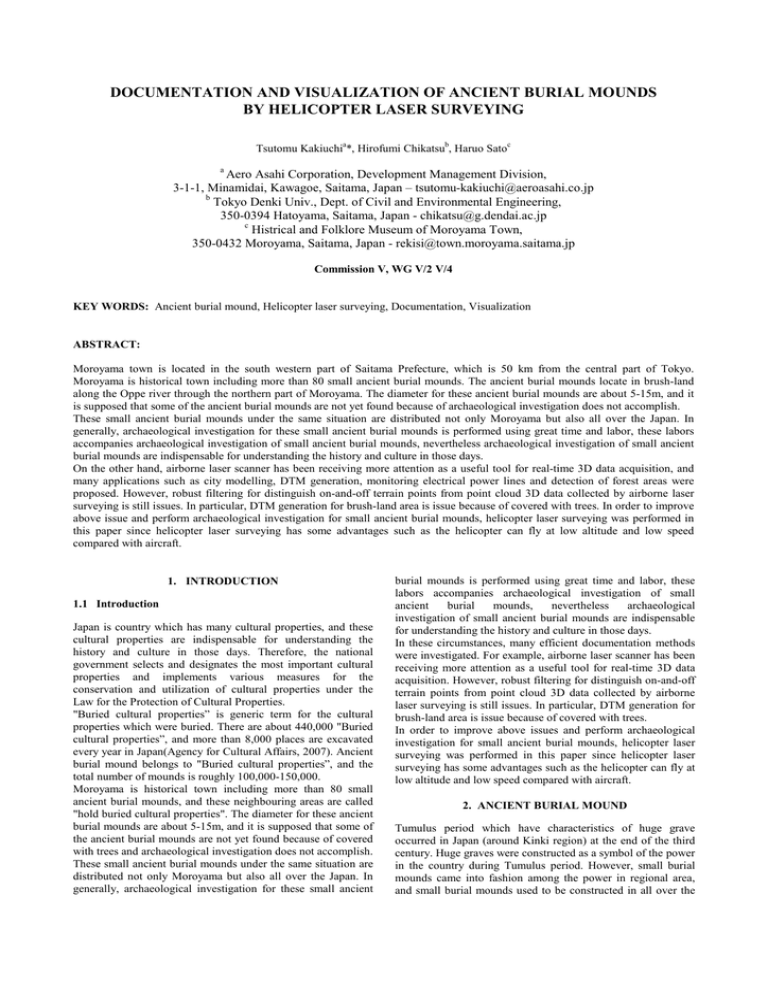
DOCUMENTATION AND VISUALIZATION OF ANCIENT BURIAL MOUNDS BY HELICOPTER LASER SURVEYING Tsutomu Kakiuchia*, Hirofumi Chikatsub, Haruo Satoc a Aero Asahi Corporation, Development Management Division, 3-1-1, Minamidai, Kawagoe, Saitama, Japan – tsutomu-kakiuchi@aeroasahi.co.jp b Tokyo Denki Univ., Dept. of Civil and Environmental Engineering, 350-0394 Hatoyama, Saitama, Japan - chikatsu@g.dendai.ac.jp c Histrical and Folklore Museum of Moroyama Town, 350-0432 Moroyama, Saitama, Japan - rekisi@town.moroyama.saitama.jp Commission V, WG V/2 V/4 KEY WORDS: Ancient burial mound, Helicopter laser surveying, Documentation, Visualization ABSTRACT: Moroyama town is located in the south western part of Saitama Prefecture, which is 50 km from the central part of Tokyo. Moroyama is historical town including more than 80 small ancient burial mounds. The ancient burial mounds locate in brush-land along the Oppe river through the northern part of Moroyama. The diameter for these ancient burial mounds are about 5-15m, and it is supposed that some of the ancient burial mounds are not yet found because of archaeological investigation does not accomplish. These small ancient burial mounds under the same situation are distributed not only Moroyama but also all over the Japan. In generally, archaeological investigation for these small ancient burial mounds is performed using great time and labor, these labors accompanies archaeological investigation of small ancient burial mounds, nevertheless archaeological investigation of small ancient burial mounds are indispensable for understanding the history and culture in those days. On the other hand, airborne laser scanner has been receiving more attention as a useful tool for real-time 3D data acquisition, and many applications such as city modelling, DTM generation, monitoring electrical power lines and detection of forest areas were proposed. However, robust filtering for distinguish on-and-off terrain points from point cloud 3D data collected by airborne laser surveying is still issues. In particular, DTM generation for brush-land area is issue because of covered with trees. In order to improve above issue and perform archaeological investigation for small ancient burial mounds, helicopter laser surveying was performed in this paper since helicopter laser surveying has some advantages such as the helicopter can fly at low altitude and low speed compared with aircraft. 1. INTRODUCTION 1.1 Introduction Japan is country which has many cultural properties, and these cultural properties are indispensable for understanding the history and culture in those days. Therefore, the national government selects and designates the most important cultural properties and implements various measures for the conservation and utilization of cultural properties under the Law for the Protection of Cultural Properties. "Buried cultural properties” is generic term for the cultural properties which were buried. There are about 440,000 "Buried cultural properties”, and more than 8,000 places are excavated every year in Japan(Agency for Cultural Affairs, 2007). Ancient burial mound belongs to "Buried cultural properties”, and the total number of mounds is roughly 100,000-150,000. Moroyama is historical town including more than 80 small ancient burial mounds, and these neighbouring areas are called "hold buried cultural properties". The diameter for these ancient burial mounds are about 5-15m, and it is supposed that some of the ancient burial mounds are not yet found because of covered with trees and archaeological investigation does not accomplish. These small ancient burial mounds under the same situation are distributed not only Moroyama but also all over the Japan. In generally, archaeological investigation for these small ancient burial mounds is performed using great time and labor, these labors accompanies archaeological investigation of small ancient burial mounds, nevertheless archaeological investigation of small ancient burial mounds are indispensable for understanding the history and culture in those days. In these circumstances, many efficient documentation methods were investigated. For example, airborne laser scanner has been receiving more attention as a useful tool for real-time 3D data acquisition. However, robust filtering for distinguish on-and-off terrain points from point cloud 3D data collected by airborne laser surveying is still issues. In particular, DTM generation for brush-land area is issue because of covered with trees. In order to improve above issues and perform archaeological investigation for small ancient burial mounds, helicopter laser surveying was performed in this paper since helicopter laser surveying has some advantages such as the helicopter can fly at low altitude and low speed compared with aircraft. 2. ANCIENT BURIAL MOUND Tumulus period which have characteristics of huge grave occurred in Japan (around Kinki region) at the end of the third century. Huge graves were constructed as a symbol of the power in the country during Tumulus period. However, small burial mounds came into fashion among the power in regional area, and small burial mounds used to be constructed in all over the Japan at latter Tumulus period, from the end of 6th century to the 7th century. An ancient burial mound is divided into several types in the forms such as keyhole-shaped tomb, rectangular-shaped tomb, burial mound and so on. Figure 1 shows the small ancient burial mound. Figure 1. Small ancient burial mound (kawakado area) 2.1 Case Study Area There are 3 ancient burial mound groups which were called Oorui, Kawakado and Saido in Moroyama town. This is proof that the power lived in Moroyama area in the latter the Tumulus period. Oorui and Kawakado are case study area of this investigation. Oorui ancient burial mound group is located in the northeast of Moroyama, and 39 ancient burial mounds including 2 keyhole-shaped tombs were confirmed. Kawakado ancient burial mound group is located in the southwest of Oorui, and 38 small ancient burial mounds in brush-land along the Oppe river were confirmed. Figure 2 shows the case study area and helicopter laser surveying was performed. and grasses. Therefore, helicopter laser surveying performed in defoliation time in the winter season in investigation (January 31, 2007). Figure 3 shows photograph of the Kawakado area when laser surveying performed. was this the was Figure 3. Kawakado area including small ancient burial mounds in brush-land 2.2 Laser Scanner System Airborne laser scanning enables to acquire point cloud 3D data using laser pulses which are reflected from the surface of the ground or objects. Platform is classified into two different types: a fixed wing type as aircrafts and a rotary wing type as helicopters. In generally, the more high dense 3D data and the more flexibility can be acquired, the lower speed by airborne. Therefore, helicopter was used in this investigation instead of aircraft, and Inertial Measurement Unit (IMU) and Global Positioning System (GPS) were used. Figure 4 shows the helicopter, and Table 1 shows the specification of laser scanner system. Figure 4. Helicopter(AS355) Figure 2. Investigation area (Moroyama town) In generally, laser scanning data which is acquired by airborne is strongly influenced by covered vegetation such as the trees ALTM3100-AG4(Optech Co.,) 1064nm(Nd:YAG) 100,000Hz 70Hz ±30° 0.25mrad Horizontal:1/3000* Altitude(m) Vertical:±0.15m/shot Table 1. Specification of laser scanner system Model No of the system Laser wave length Pulse repetition frequency Scan frequency Scan angle Beam divergence Accuracy 3. EXTRACTION OF ANCIENT BURIAL MOUND Helicopter laser surveying was performed to extract ancient burial mounds covered with trees, and robust filtering method for on-and-off terrain points were investigated. Main extraction flow for ancient burial mound is follows. 1. Acquisition of point cloud 3D data by helicopter laser surveying. 2. DTM generation by filtering processing. 3. Extract shape of small ancient burial mounds from DTM. data for the interest point as a noise when the height value is larger than the threshold value. Figure 6 shows the principles of median filtering. Input image 3.1 Helicopter Laser Surveying The helicopter laser surveying can acquire high density and high precise point cloud 3D data because helicopter can fly with low altitude and low speed compared with aircraft. The flight speed and flight altitude were 50km/h and 550m respectively in this investigation. In addition, the laser scanner system have ability to acquire the first pulse data which are the pulse that returns first from the object, and the last pulse data which are the pulse that returns last from the object. In order to generate DTM, the last pulse data was used in this investigation since the last pulse data have ability to detect the surface. Figure 5 shows a color gradation map, which was acquired using the last pulse data for Kawakado area. sorted list output image 0, 0, 0, 0, 0, 0, 0, 0,10 Median 0 0 0 0 0 0 0 10 0 0 remove 0 0 0 0 0 0 0 Figure 6. Example of the median operator 3.3 Extraction of Ancient Burial Mounds As the first step for extraction of the ancient burial mounds, size for the ancient burial mounds in Kawakado area are assumed as about 1-1.5m in height and 5-15m diameter. This means that more than 2m height data should be removed as not ancient burial mounds. Figure 7 shows the results using 2m height as a threshold value, and the ancient burial mounds should be being under 2m height, namely black area on the Figure 7. Here, 50*50 mask size (one grid size is 30*30cm) was adopted for 15*15m area so that the whole burial mound is covered. Figure 5. Gradation Map by Last Pulse Data (Kawakado) 3.2 Filtering Filtering of point cloud 3D data collected by airborne laser scanner means removing of the height-values such as trees, houses and the other objects, and various filtering methods have been developed, e.g., morphological filtering using weights depending on the window sizes (Kilian, et. al. 1996), using function consist of height difference and distance between two points (Vosselman, 2000), using standard deviation image (Lohman, et. al. 2000). Furthermore, filtering using first and last return height (Alharthy & Bethel, 2002), filtering using energy function by height difference (Elmqvist, 2002), alternative the deepest points and height difference, filtering using slope angle for a piecewise planar surface (Sohn & Dowman, 2002) were developed respectively. In order to extract the ancient burial mounds, the trees, houses and the other objects also should be removed by filtering. With this motive, median filter based on height difference are investigated using grid data which were transformed from random data. Median filter have ability to remove the height Figure 7. Result of filtering processing As the next step, after the black area on the Figure 7 was interpolated using the deepest data, filtering with 0.2m threshold was performed using same mask size under assumption that the height of the ancient burial mounds is larger than 0.2m and less than 2m. Figure 8 shows the interpolated map, and Figure 9 shows the extracted the ancient burial mounds (black area). 4. EVALUATION OF FILTERING In order to evaluate filtering results, the given position for the known ancient burial mounds were marked with white circle on the figure 11. As a result, it can be found that many candidate areas as the ancient burial mounds were extracted. However, it can be confirmed that all known ancient burial mounds extracted perfectly. Figure 8. Interpolated Map Figure 11. Extracted Candidate of Ancient Burial Mounds Figure 9. Extracted Candidate of Ancient Burial Mounds It can be seen that the ancient burial mounds were extracted efficiently. However, it can be found many black areas which doesn’t show ancient burial mounds. In order to improve extraction of the ancient burial mounds, each black area was evaluated using the area and circle ratio under estimation that the shape of the ancient burial mounds show round shape with 5-15m diameter. Figure 10 shows the final results. It can be found that the small round area or irregular area were removed as a except of the ancient burial mounds. In other wards, the proposed filtering methods have ability to extract topography which have the same characteristic of the ancient burial mound. For example, figure 12 shows one of extracted topography which does not the ancient burial mound. Furthermore, proposed filtering method was applied to Oorui area using 75*75 mask size (one grid size is 30*30cm) so that the keyhole-shaped tomb can be extracted, and Figure 13 shows the results. Similarly, it can be seen that all known ancient burial mounds including keyhole-shaped tomb were extracted perfectly. Figure 12. Same characteristic of the ancient burial mound Figure 10. Extracted Ancient Burial Mounds in Kawakado As the result, it is verified that all ancient burial mounds are extracted automatically and perfectly by the proposed filtering method based on height difference. Furthermore, the proposed filtering method was applied to Oorui area, and it is also confirmed that all known ancient burial mounds including keyhole-shaped tomb were extracted perfectly. On the contrary, it can be said that the proposed filtering methods have ability to extract topography which have the same characteristic of the ancient burial mound. Consequently, it is concluded that the proposed filtering methods is expected to become robust method in the various shape extraction. There is issue, however, for further work. This problem is determination of threshold value. References: Agency for Cultural Affairs, 2007, http://www.bunka.go.jp/index.html Alharthy, A., Bethel, J., 2002. Heuristic Filtering and 3D Feature Extraction from Lider Data. IAPRS, Vol.34, Part 3A, Granz, Austria, pp. A.29-A.35. Figure 13. Extracted Ancient Burial Mounds in Oorui Elmqvist, M., 2002. Ground Surface estimation fromairborne Laser Scanner Data using Active Shape Models. IAPRS, Vol.34, 5. .VISUALIZATION Recently, 3 dimensional visualization has been receiving more attention as a useful method to understand engineering phenomenon intuitively, or to find out important elements that we can’t detect in usual simulation. Furthermore, visualization under virtual environment is efficient method from a view point that people can appreciate or experience the archaeological objects or historical space through the computer. With this motive, 3D animation for Kawakado area was performed. Figure 14 shows one of scene for 3D animation for Kawakado area. Part 3A, Granz, Austria, pp. A.114-A.118. Kilian, J., Haala, N., Englich, M., 1996. Capture and Evaluation of Airborne Laser Scanner Data. IAPRS, Vol.XXXI, Part B3, Vienna, Austria, pp. 383-388. Lohmann, P., Koch, A., Schaeffer, M., 2000. Approaches to the Filtering of Laser Scanner Data. IAPRS, Vol.XXXIII, Part B3, Amsterdam, The Netherlands, pp. 540-547. Sohn, G., Dowman, I., 2002. Terrain Surface Reconstruction by the use of Tetrahedron Model with the MDL Criterion. IAPRS, Vol.34, Part 3A, Granz, Austria, pp. A.336-A.344. Vosselman, G., 2000. Slope Based Filtering of Laser Altimetry Data. IAPRS, Vol.XXXIII, Part B3, Amsterdam, The Netherlands, pp. 935-942. Figure 14. Bird’s-eye View for Kawakado Area 6. CONCLUSIONS Airborne laser surveying is one of the efficient methods to extract the ancient burial mounds which locate in brush-land. In generally, the more high dense 3D data and the more flexibility can be acquired, the lower speed by airborne. Therefore, archaeological investigation for the small ancient burial mounds, helicopter laser surveying was performed, and filtering method for extraction of the ancient burial mounds was proposed in this investigation.
